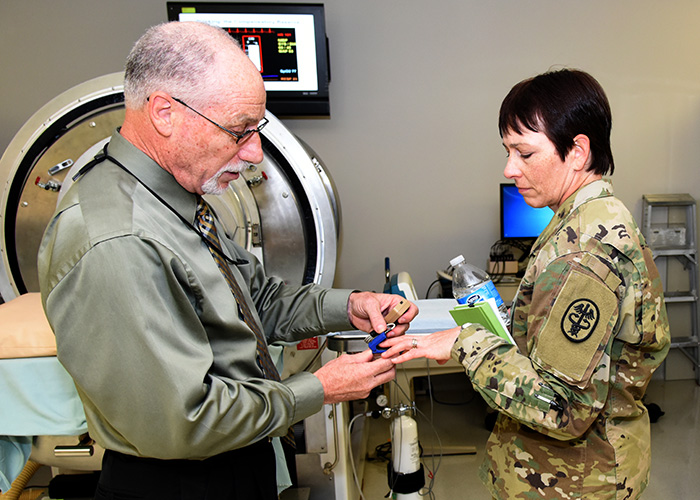Tiny Life-Saving Device Receives FDA Clearance

The ability to measure the body's capacity to compensate for blood loss - also known as the compensatory reserve - has been the focus of researchers at the U.S. Army Institute of Surgical Research, at Fort Sam Houston, Texas, for years. Hemorrhagic shock from blood loss is the leading cause of death in trauma patients. Traditional methods of taking vital signs does not detect when a patient is on the verge of crashing or going into hemorrhagic shock and potentially dying from blood loss.
With that in mind, USAISR researchers collaborated with scientists and engineers at the University of Colorado and Flashback Technologies, Inc., to develop an algorithm, the Compensatory Reserve Index, to detect when a patient is going into hemorrhagic shock. The tiny device is the first medical monitoring technology capable of providing early detection of impending circulatory shock in trauma patients and received clearance from the U.S. Food and Drug Administration in December 2016 to be used in pre-hospital and hospital settings.
"Our research has revealed that the measurement of the compensatory reserve is the single most important indicator for early and accurate assessment of imminent shock because it represents the body's ability to adjust for the threat of inadequate oxygen in the tissues due to blood loss" said Dr. Victor Convertino, USAISR senior scientist for the U.S. Army Medical Research and Materiel Command Combat Casualty Care Research Program, which funded the research.
The CRI utilizes an algorithm to take information from a standard pulse oximeter placed on the finger of a patient and gauges whether a patient requires resuscitation or immediate medical attention. Equipped with a gauge similar to a fuel gauge in a motor vehicle, the device detects when a patient is in danger of crashing or going into hemorrhagic shock. This technology will be beneficial for medics who don't have much experience in the battlefield to care for Wounded Warriors needing immediate medical attention.
"FDA clearance is a significant milestone because it paves the way for fielding a compensatory reserve measurement device to give combat medics on the battlefield a tool to predict hemorrhagic shock, as well as emergency medical technicians in civilian medical settings," said Convertino. "The ability to measure the compensatory reserve continuously and in real time will revolutionize medical monitoring from early diagnosis of the trajectory toward shock to accurately guiding fluid resuscitation or providing feedback of intervention effectiveness."
Among the first people to try out an early prototype for measuring the compensatory reserve was former Army Surgeon Maj. Gen. Patricia Horoho, who called it a "game changer" during her visit to the USAISR in 2013.
Convertino and his team were able to use the compensatory reserve algorithm to learn from an individual's own arterial waveform how the body is using its compensatory mechanisms. The research team learned that waveforms obtained from a simple pulse oximeter that is carried by combat medics could be used to generate a compensatory reserve measurement device.
"With newly advanced computer technologies, we now have the capability to measure features of each arterial waveform that reflect the sum of all mechanisms of compensation that affect the heart (ejected wave) and the arteries (reflected wave)," said Convertino.
With analysis of each arterial waveform, the algorithm becomes more accurate in predicting the body's ability to protect itself from inadequate tissue oxygenation (shock) or begin to decompensate.
"The compensatory reserve measurement device will be important for triage because of stressful battlefield conditions," said Convertino. "There's lots of noise, lots of adrenaline and not much equipment, which can make diagnosis especially hard for medics on the battlefield. This device will help medics save lives on the battlefield."
Additionally, the compensatory reserve measurement algorithm was recognized with an Emergency Medical Services "Top 10 Innovation of the Year Award" at the 2014 EMS Today Conference and Exposition in Washington, D.C.














